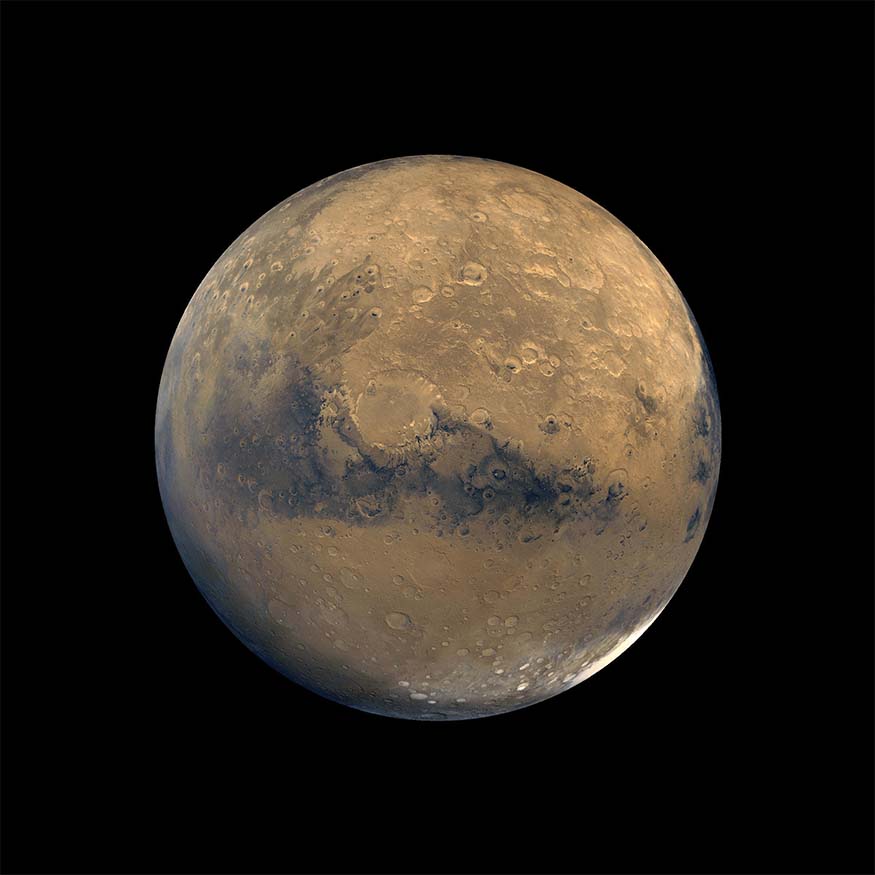
BEAUTY: 
BRAGGING RIGHTS: You saw the red planet
HOW EASY IS IT TO SEE? Best with a small telescope
TYPE: Planet
DISCOVERED: Known since antiquity
No planet has stirred the human imagination more than Mars. Even in ancient times, the sight of this red star, which some years grows bright and angry, inspired stories of gods and mortals.
Once telescopes were invented, the surface features of this planet, including ice caps and continent-size splotches, inspired scientists and artists alike to speak of Mars as a world like Earth. It was certainly not hard for Percival Lowell, looking at Mars in the 1890s, to imagine that he saw vast canals created by a dying race thirsty for water.
Even after the first space probes visited Mars and saw only barren deserts, the allure of the planet was undiminished. Pictures from the surface, by the Viking landers in the 1970s, made Mars look like any other place on Earth—a place that you could imagine yourself walking around on.
Though Lowell’s canals turned out to be imaginary, he was right about one thing: water is the key to life. If there was once water on Mars (and all signs suggest there was, and a lot of it) then perhaps there was life too. And even if there isn’t liquid water on the planet now, it exists locked in ice at the frozen poles, where it could easily be used to support the life of future astronauts and even colonizers.
WHAT YOU MIGHT SEE THROUGH AMATEUR EQUIPMENT
Someday, I imagine, maybe in the lifetime of some of you reading this book, humans will land on Mars and walk around. They’ll unravel many mysteries, and no doubt stumble into many more. And maybe bit by bit, they’ll turn Mars into something new: no longer a farflung world, but a home.
Until then, and probably even then, we can always look up at Mars and let it inspire us.
The distance from Earth to Mars varies depending on where they are in their orbits. Sometimes Mars is on the other side of the sun from Earth—at those times, not only is Mars invisible (because it is behind the sun) but it is also the farthest away from Earth it can be. Every 26 months or so, Earth and Mars get close to each other. This is known as opposition and it is the best time to view Mars from Earth. The table on the next page lists some upcoming opposition dates.
Even at opposition, however, Mars appears smaller than Jupiter—its tiny disk will be just 25 arcseconds across. (There are 60 arcseconds in an arcminute, and the full moon is 30 arcminutes across, so Mars will appear 72 times smaller than the moon—basically the size of a small lunar crater.)
Use a medium-size telescope to resolve as much detail as you can. Light pollution won’t be a problem because Mars is bright, but you must wait for steady skies. Too much turbulence in the air will scramble your view. Cold and clear winter nights are your best bet.
Red color. Even without a telescope Mars’s color will be obvious. It won’t look as saturated as the red light of an airplane’s light, but you will notice a distinct reddish/orange hue. This red comes from the oxidized—that is, rusted—sands of Mars.
Retrograde motion. If you draw the position of Mars against the stars you’ll notice that it moves from night to night. In the days before opposition, Mars will seem to move backwards. Then after opposition, Mars will start to move forward again. This is known as retrograde motion, and it occurs because of the relative positions of Mars and Earth. As the Earth passes Mars in its orbit, it looks like Mars is temporarily going backwards. Retrograde motion is difficult to explain if all planets revolve around Earth, and it ultimately led to Copernicus’s theory that Earth and Mars both revolve around the sun.
Polar ice caps. With sufficient magnification you might be able to see a white patch at one end of Mars. This is a polar ice cap, and it consists of water ice and solid carbon dioxide (dry ice).
Syrtis Major. Seeing other surface features on Mars requires steady skies and lots of patience. Syrtis Major is one of the most obvious. It generally appears as a triangular dark patch. If you’re looking through a small telescope, try using a red filter to enhance the contrast. Areas like Syrtis Major will appear darker and hopefully more obvious.
|
DATES WHEN MARS IS AT OPPOSITION AND WHERE TO LOOK |
|
DATE |
CONSTELLATION |
July 27, 2018 |
Capricorn |
October 13, 2020 |
Pisces |
December 8, 2022 |
Taurus |
January 16, 2025 |
Gemini |
February 19, 2027 |
Leo |